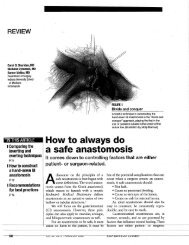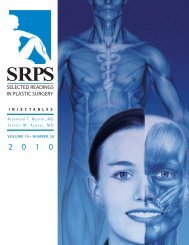SRPS PS - Plastic Surgery Internal
SRPS PS - Plastic Surgery Internal
SRPS PS - Plastic Surgery Internal
You also want an ePaper? Increase the reach of your titles
YUMPU automatically turns print PDFs into web optimized ePapers that Google loves.
<strong>SR<strong>PS</strong></strong> Volume 10, Issue 25, 2009<br />
The free groin flap constitutes an unsurpassed<br />
donor site and allows the transfer of a large quantity of<br />
hairless skin. Like the pedicled groin flap, it is too<br />
bulky for resurfacing the hand and requires revision<br />
defatting and/or liposuction.<br />
Recent interest in perforator flaps has led to the<br />
growing popularity of the anterolateral thigh flap 544,545<br />
and the tensor fasciae latae perforator flap 546,547 in<br />
dorsal hand reconstruction. Large flaps of very thin<br />
skin can be raised with minimal donor site<br />
morbidity. Because the flaps are based on perforating<br />
vessels, the motor function of the underlying tensor<br />
fascia latae is preserved.<br />
The anatomy of the temporal region has been<br />
elucidated by several authors. 548–550 Upton et al. 551<br />
discussed the various applications of free<br />
temporoparietal fascial flaps in dorsal hand<br />
resurfacing. Temporoparietal fascia most commonly is<br />
used in the upper extremity to wrap exposed or<br />
contracted tendons. 551–556 The deep areolar surface of the<br />
flap is turned toward the tendons to provide a smooth<br />
gliding surface. The overlying fascia is thin and pliable<br />
for metacarpal contouring. A skin graft completes the<br />
reconstruction. This fascial flap is also excellent for<br />
filling the three-dimensional defect resulting from the<br />
extensive release of complex first web space<br />
REFERENCES<br />
1. Brucker MJ, Edstrom L. The use of grafts in acute<br />
and chronic fingernail deformities. J Am Soc Surg<br />
Hand 2002;2:14–20.<br />
2. Zook EG. Anatomy and physiology of the<br />
perionychium. Hand Clin 1990;6:1–7.<br />
3. Verdan CE, Egloff DV. Fingertip injuries. Surg<br />
Clin North Am 1981;61:237–266.<br />
4. Guy RJ. The etiologies and mechanisms of nail<br />
bed injuries. Hand Clin 1990;6:9–19.<br />
5. Ashbell TS, Kleinert HE, Putcha SM, Kutz JE. The<br />
deformed finger nail, a frequent result of failure<br />
to repair nail bed injuries. J Trauma<br />
1967;7:177–190.<br />
6. Van Beek AL, Kassan MA, Adson MH, Dale V.<br />
Management of acute fingernail injuries. Hand<br />
Clin 1990;6:23–35.<br />
7. Stevenson TR. Fingertip and nailbed injuries.<br />
28<br />
contractures. The donor defect on the scalp is<br />
insignificant. Potential complications of flap transfer<br />
include palsy of the frontal branch of the facial nerve<br />
and permanent alopecia.<br />
Another extremely thin fascial flap is the serratus<br />
anterior fascial flap. 557–560 The serratus anterior fascial flap<br />
consists of the loose areolar tissue between the latissimus<br />
dorsi and serratus anterior muscles and is supplied by<br />
the thoracodorsal vessels. It has a long constant vascular<br />
pedicle, very thin well-vascularized tissue, and low<br />
donor site morbidity, and it allows simultaneous donor<br />
and recipient site dissection. It can also be combined<br />
with other flaps of the subscapular system.<br />
Free muscle flaps can provide only crude<br />
protective sensibility through pressure receptors, but<br />
their malleability makes them well suited to difficult<br />
contour problems in the hand, especially the palm. For<br />
small defects, the serratus anterior 561,562 seems most<br />
useful, and for moderate-sized wounds, the rectus<br />
abdominis 563,564 flap has been suggested. For very large<br />
wounds of the upper extremity, the latissimus dorsi is<br />
the muscle of choice. These three flaps have largediameter<br />
pedicles of very adequate length with<br />
minimal donor site morbidity. Functional free muscle<br />
transfers are discussed in the “Microsurgery” issue of<br />
Selected Readings in <strong>Plastic</strong> <strong>Surgery</strong>.<br />
Orthop Clin North Am 1992;23:149–159.<br />
8. Bindra RR. Management of nail–bed fracturelacerations<br />
using a tension-band suture. J Hand<br />
Surg [Am] 1996;21:1111–1113.<br />
9. Inglefield CJ, D’Arcangelo M, Kolhe <strong>PS</strong>. Injuries<br />
to the nail bed in childhood. J Hand Surg [Br]<br />
1995;20:258–261.<br />
10. McCash CR. Free nail grafting. Br J Plast Surg<br />
1955;8:19–33.<br />
11. Shepard GH. Nail grafts for reconstruction. Hand<br />
Clin 1990;6:79–102.<br />
12. Zook EG, Russell RC. Reconstruction of a<br />
functional and esthetic nail. Hand Clin<br />
1990;6:59–68.<br />
13. Pessa JE, Tsai TM, Li Y, Kleinert HE. The repair of<br />
nail deformities with the nonvascularized nail<br />
bed graft: Indications and results. J Hand Surg<br />
[Am] 1990;15:466–470.






